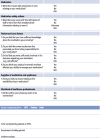Capturing Patients' Perspectives on Medication Safety: The Development of a Patient-Centered Medication Safety Framework
- PMID: 30882613
- PMCID: PMC7678656
- DOI: 10.1097/PTS.0000000000000583
Capturing Patients' Perspectives on Medication Safety: The Development of a Patient-Centered Medication Safety Framework
Abstract
Objectives: Medication safety incidents are common in primary care and contributory factors frameworks can assist in our understanding of their causes. A framework that is positioned from the perspective of patients would be advantageous in practice when seeking patient insights into medication safety. The aim of this study was to develop a patient-centered contributory factors framework for examining medication safety incidents.
Methods: A purposive sample of 106 members of the public, patients, and carers were recruited to take part in focus groups (n = 18). Focus groups were audio recorded, transcribed, and analyzed using a thematic framework. A patient and public involvement group was set up to undertake multiple roles in the research process, including the development of the focus group schedule, analysis of the data, and the construction of a patient-centered framework of contributory factors (patient-centered medication safety) and implementation checklist.
Results: The findings highlighted the importance of communication, supplies of medication and appliances, patient- and carer-related factors, healthcare professional factors, and computer systems and programs in the safe use of medicines. Some contributory factors were unique to primary care patients such as access to services and continuity of care. In conjunction with a patient and public involvement group, a framework of factors that patients believe contribute to medication safety incidents in primary care was developed that could be used by patients and healthcare professionals.
Conclusions: The patient-centered medication safety framework and implementation checklist provides a novel tool to examine contributory factors that can lead to medication safety incidents from patients' perspective.
Conflict of interest statement
The authors disclose no conflict of interest.
Figures
Similar articles
-
Towards understanding and improving medication safety for patients with mental illness in primary care: A multimethod study.Health Expect. 2024 Jun;27(3):e14095. doi: 10.1111/hex.14095. Health Expect. 2024. PMID: 38817038 Free PMC article.
-
Patient and carer identified factors which contribute to safety incidents in primary care: a qualitative study.BMJ Qual Saf. 2015 Sep;24(9):583-93. doi: 10.1136/bmjqs-2015-004049. Epub 2015 May 13. BMJ Qual Saf. 2015. PMID: 25972223
-
The patient experience of patient-centered communication with nurses in the hospital setting: a qualitative systematic review protocol.JBI Database System Rev Implement Rep. 2015 Jan;13(1):76-87. doi: 10.11124/jbisrir-2015-1072. JBI Database System Rev Implement Rep. 2015. PMID: 26447009
-
Evaluation of Patient and Family Engagement Strategies to Improve Medication Safety.Patient. 2018 Apr;11(2):193-206. doi: 10.1007/s40271-017-0270-8. Patient. 2018. PMID: 28795338 Review.
-
Making inpatient medication reconciliation patient centered, clinically relevant and implementable: a consensus statement on key principles and necessary first steps.J Hosp Med. 2010 Oct;5(8):477-85. doi: 10.1002/jhm.849. J Hosp Med. 2010. PMID: 20945473
Cited by
-
Public Knowledge, Attitudes, and Practices Regarding the Use of Over-The-Counter (OTC) Analgesics in Indonesia: A Cross-Sectional Study.Patient Prefer Adherence. 2023 Oct 17;17:2569-2578. doi: 10.2147/PPA.S426290. eCollection 2023. Patient Prefer Adherence. 2023. PMID: 37869729 Free PMC article.
-
Older patient participation in discharge medication communication: an observational study.BMJ Open. 2023 Mar 23;13(3):e064750. doi: 10.1136/bmjopen-2022-064750. BMJ Open. 2023. PMID: 36958781 Free PMC article.
-
Towards understanding and improving medication safety for patients with mental illness in primary care: A multimethod study.Health Expect. 2024 Jun;27(3):e14095. doi: 10.1111/hex.14095. Health Expect. 2024. PMID: 38817038 Free PMC article.
-
Visual impairment and medication safety: a protocol for a scoping review.Syst Rev. 2021 Sep 15;10(1):248. doi: 10.1186/s13643-021-01800-8. Syst Rev. 2021. PMID: 34526103 Free PMC article.
-
Systematic review on the frequency and quality of reporting patient and public involvement in patient safety research.BMC Health Serv Res. 2024 Apr 26;24(1):532. doi: 10.1186/s12913-024-11021-z. BMC Health Serv Res. 2024. PMID: 38671476 Free PMC article.
References
-
- Taylor-Adams S, Vincent C, Street P. Systems analysis of clinical incidents: the London protocol. Clin Risk. 2004;10:211–220.
-
- Berwick D. A promise to learn—a commitment to act—improving the safety of patients in England, 2013. National Advisory Group on the Safety of Patients in England, Crown. 2013.
MeSH terms
LinkOut - more resources
Full Text Sources
Medical




